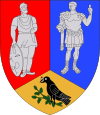Turdaș
Turdaș | |
|---|---|
 Reformed church in Turdaș | |
 Location in Hunedoara County | |
| Coordinates: 45°51′11″N 23°07′23″E / 45.853°N 23.123°E | |
| Country | Romania |
| County | Hunedoara |
| Government | |
| • Mayor (2020–2024) | Remi Bocșeri (PSD) |
| Area | 32.78 km2 (12.66 sq mi) |
| Elevation | 203 m (666 ft) |
| Population (2021-12-01)[1] | 1,791 |
| • Density | 55/km2 (140/sq mi) |
| Time zone | EET/EEST (UTC+2/+3) |
| Postal code | 337495 |
| Area code | (+40) 02 54 |
| Vehicle reg. | HD |
| Website | www |
Turdaș (Hungarian: Tordos, German: Tordesch) is a commune in Hunedoara County, Transylvania, Romania. It is composed of four villages: Pricaz (Perkász), Râpaș (Répás), Spini (Pád), and Turdaș.
Turdaș lies on the left bank of the Mureș River, which surrounds the village to the north and west. The Turdaș River discharges into the Mureș in the village Turdaș. To the east is the Sitiș stream, which separates the Turdaș and Pricaz villages. The commune is located in the central-east part of Hunedoara County, 6 km (3.7 mi) from Orăștie and 20 km (12 mi) from the county seat, Deva.
Turdaș has been attested to in various relics found in museums in Germany and Romania. The first is a tax collector report dated to 1334, where in the Catholic priest paid one silver mark in taxes; the Germans in the region were Catholic until the 16th century. According to the report the village had 56 "smokes" or chimneys, i.e., houses. Turdaș is located in an area of Transylvanian Saxon settlement, and the village traditionally had a strong German population.[2][page needed][3]
This is the location of the Turdaș archaeological site, some 7000 years old. The archaeological site was a large Neolithic/Chalcolithic settlement along the course of the river Mureș. It was first researched by Zsófia Torma. The sub-culture Vinča-Turdaș (a late, regional variation of the Vinča culture) is named after this site. Some archaeological culture layers at this site are contemporary with the site at Tărtăria.
Natives[edit]
- Aurel Vlad (1875 – 1953), lawyer and politician who served as Finance Minister in 1919–1920.
References[edit]
- ^ "Populaţia rezidentă după grupa de vârstă, pe județe și municipii, orașe, comune, la 1 decembrie 2021" (XLS). National Institute of Statistics.
- ^ Dörner, Anton (2003). Documente și cronici privind istoria orașului și scaunului Orăștie. Cluj-Napoca: Argonaut. ISBN 9737710088.
- ^ Urkundensammlung [Colecţia de documente medievale], Serie U. V, Nova Collectio posterior (Inventar 28), Nr. 1829 (in Latin). Hermannstadt, Staatsarchiv(Sibiu): Trier University. pp. 464–465. Retrieved 12 June 2022.
Item feria secunda scilicet secundo die beati Briccii 6) dicavi villam Tordas et inveni in ea quinquaginta sex fumos, et Corrardus plebanus de eadem solvit unam 2) marcam maioris ponderis minus lotone.



